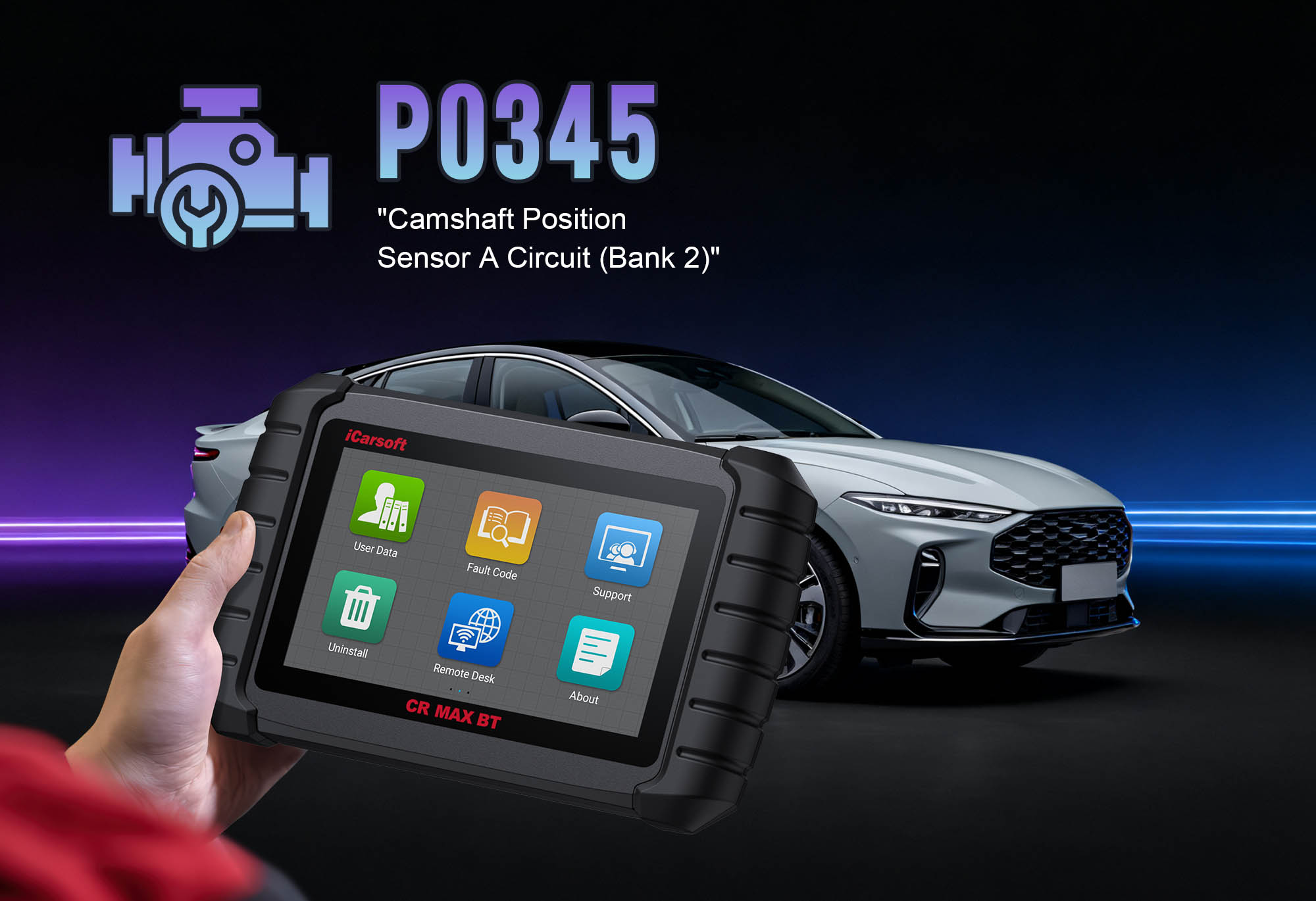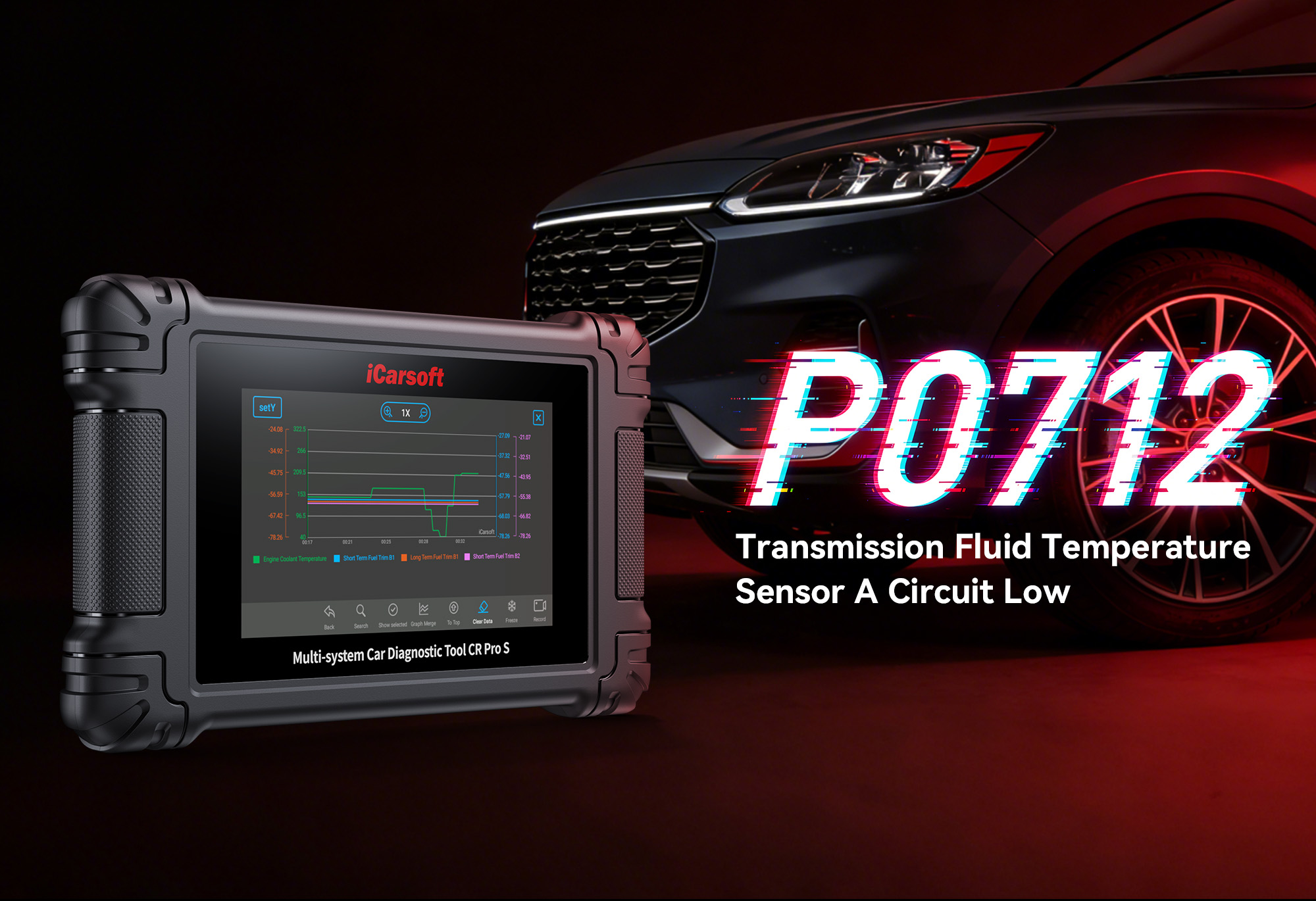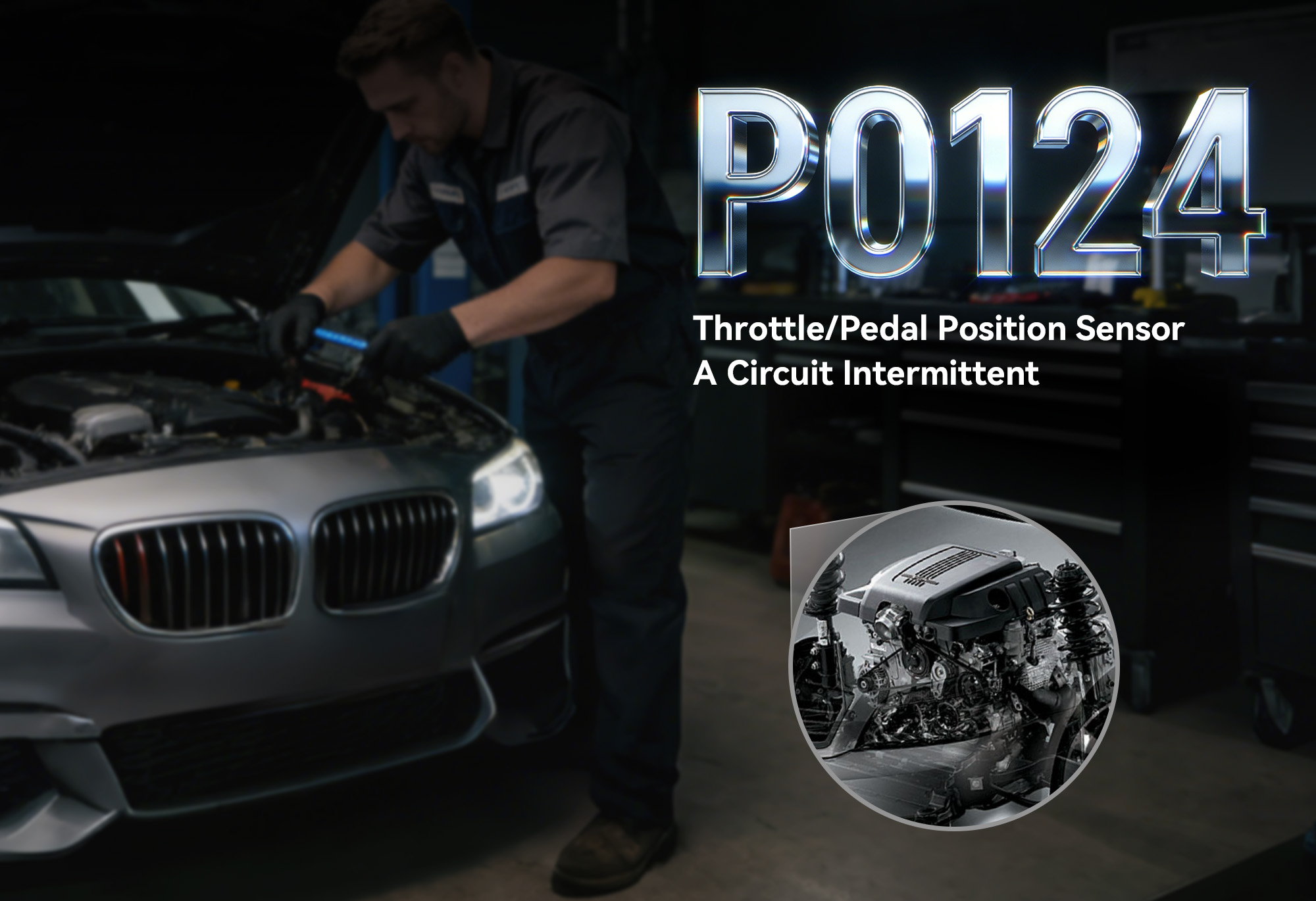Diagnose & Clear P0345 with iCarsoft CR MAX BT: Fix Camshaft Position Sensor Circuit (Bank 2, Sensor A)
If your check engine light illuminates and a scan returns P0345, your vehicle’s engine management system is signaling a problem with the camshaft position sensor in Bank 2. This OBD-II code stands for "Camshaft Position Sensor A Circuit Malfunction (Bank 2)"—indicating the Engine Control Module (ECM) has detected an abnormal voltage, no signal, or intermittent communication from the camshaft position sensor responsible for monitoring Bank 2’s camshaft rotation.
Camshaft position sensors play a critical role in synchronizing fuel injection and ignition timing by tracking camshaft position and speed. Bank 2’s Sensor A (typically the intake camshaft sensor in dual-cam engines) sends precise signals to the ECM, ensuring valves open and close at the correct time. When P0345 occurs, this communication breaks down, leading to rough idling, misfires, reduced power, or even stalling—especially under acceleration.
Basic scanners may only flag "camshaft sensor fault" but can’t analyze signal patterns or distinguish between sensor, wiring, or ECM issues. The iCarsoft CR MAX BT—with its wireless waveform analysis, real-time signal monitoring, and component activation tests—solves this. Let’s explore how to diagnose and resolve P0345 using this advanced tool.
 iCarsoft CR MAX BT displaying Bank 2 camshaft sensor waveform, RPM sync data, and timing system metrics for P0345 diagnosis
iCarsoft CR MAX BT displaying Bank 2 camshaft sensor waveform, RPM sync data, and timing system metrics for P0345 diagnosis
Understanding P0345: Causes & Key Symptoms
A malfunctioning camshaft position sensor in Bank 2 disrupts engine timing, leading to distinct performance issues:
Key Symptoms of P0345
-
Check Engine Light: Illuminates when the ECM detects no signal, erratic voltage, or a short/open circuit in Bank 2’s camshaft sensor circuit for 2+ drive cycles.
-
Rough Idle: Unsynchronized valve timing causes uneven combustion, resulting in noticeable vibrations at idle (500–800 RPM).
-
Misfires & Hesitation: Delayed or incorrect ignition timing leads to power loss during acceleration (e.g., lag when merging onto highways).
-
Stalling: In severe cases, the ECM can’t adjust timing dynamically, causing the engine to shut off unexpectedly (common at stops or low speeds).
-
Reduced Fuel Efficiency: Poor timing increases fuel consumption by 10–15% as the engine burns more fuel to compensate for incomplete combustion.
-
Hard Starting: The engine may crank 2–3 seconds longer than usual or fail to start entirely—without camshaft data, the ECM can’t set initial timing.
Common Causes of P0345
|
Cause
|
Description
|
|
Faulty Camshaft Position Sensor (Bank 2, Sensor A)
|
Internal electrical failure (e.g., worn magnetic coil or Hall-effect chip) prevents accurate signal transmission—accounts for ~45% of P0345 cases.
|
|
Damaged Wiring or Connector
|
Frayed wires, corroded terminals, or loose plugs disrupt signal flow between the sensor and ECM—worsened by engine heat or vibration.
|
|
Sensor Alignment Issues
|
Misalignment (common after timing belt/chain replacement) creates a gap between the sensor and camshaft teeth, blocking signal detection.
|
|
Oil Contamination
|
Leaking valve cover gaskets or front crankshaft seals flood the sensor with oil, damaging its internal electronics and shorting the circuit.
|
|
Failed Timing Chain/Belt
|
A stretched, skipped, or broken timing chain/belt throws off camshaft-crankshaft synchronization, triggering false sensor errors.
|
|
ECM Malfunction (Rare)
|
A faulty ECM misinterprets normal sensor data, usually paired with other communication codes (e.g., U0100, U0121).
|
Why iCarsoft CR MAX BT Excels at Diagnosing P0345
The CR MAX BT outperforms basic tools with features tailored to camshaft sensor and timing system diagnostics—critical for pinpointing P0345’s root cause:
Wireless Waveform Analysis
Streams real-time voltage patterns from Bank 2’s camshaft sensor to your device, identifying missing pulses, erratic spikes, or flatlines (key indicators of sensor failure).
Dual Bank Comparison
Side-by-side data for Bank 1/Bank 2 camshaft sensors highlights discrepancies (e.g., Bank 1 signal is steady, Bank 2 cuts out) to isolate Bank 2 issues.
Sensor Signal Testing
Measures signal frequency (Hz) and amplitude (V), comparing them to manufacturer specs (e.g., 0.5–5V AC for magnetic sensors, 5V DC pulses for Hall-effect).
Bi-Directional Control
Sends commands to activate related components (e.g., variable valve timing solenoids) to verify if the issue is the sensor or the timing system.
3D Component Diagrams
Preloaded schematics show Bank 2 layout, sensor location (near camshaft sprocket), and wiring paths for 80+ makes (Toyota, Ford, Mercedes-Benz, Hyundai).
Timing Sync Integration
Cross-references crankshaft position sensor data to check camshaft-crankshaft alignment—critical for ruling out timing chain/belt issues.
Step-by-Step: Diagnose P0345 with iCarsoft CR MAX BT
-
1. Connect & Confirm the Code
Plug the CR MAX BT into your vehicle’s OBD-II port and pair it with your smartphone/tablet via the iCarsoft app (Bluetooth setup takes 30 seconds).
Select your vehicle using Auto VIN Scan (reads VIN instantly) or manual entry (make/model/year/engine).
Navigate to Engine > Fault Codes > Read Codes to confirm P0345. Tap Code Details for vehicle-specific insights (e.g., "Toyota: Bank 2 Camshaft Sensor Voltage = 0V – No Signal Detected").
-
2. Identify Bank 2 & Locate the Camshaft Sensor
Use the CR MAX BT to avoid confusion:
Bank 2 Identification:
Go to Component Location > Engine > Cylinder Banks. For V-engines, Bank 2 = cylinders farthest from the front (e.g., V6: Bank 2 = 4-5-6; V8: Bank 2 = 2-4-6-8). For inline engines, Bank 2 = the only bank (rare for 4-cylinders).
Sensor Location:
Navigate to Component Location > Engine > Timing System > Camshaft Position Sensor (Bank 2, Sensor A). The app displays a 3D diagram: Sensor A (intake cam) is typically mounted on the cylinder head, 2–4 inches from the camshaft sprocket, with a 2–3 wire connector.
-
3. Analyze Live Camshaft Sensor Data
The CR MAX BT’s real-time data reveals signal irregularities:
Start the engine (if it runs) and let it idle at 600–800 RPM.
In the app, go to Engine > Live Data > Timing System and select Bank 2 metrics:
- "Camshaft Position Sensor Voltage (Bank 2)": Normal = 0.5–5V AC (magnetic sensors) or 5V DC with pulses (Hall-effect). P0345 = 0V (no signal) or steady 5V (short).
- "Camshaft-RPM Sync": Should match crankshaft RPM (±50 RPM). Mismatches >100 RPM indicate timing chain/belt issues.
- "Signal Frequency": Normal = 50–500 Hz (varies with RPM). Zero or erratic frequency = sensor/wiring fault.
Compare to Bank 1: If Bank 1’s sensor shows stable data but Bank 2’s doesn’t, the issue is isolated to Bank 2.
-
4. Inspect the Sensor, Connector & Wiring
Physical damage or contamination is often the cause—check with guidance from the CR MAX BT:
Sensor Inspection:
Locate the sensor using the app’s diagram. Disconnect the connector and remove the sensor (use a 10–14mm socket). Check for:
- Oil deposits (sign of valve cover gasket leaks).
- Cracks in the sensor housing (from overheating or impact).
- Debris (metal shavings, dirt) on the sensor tip (blocks signal from camshaft teeth).
Connector Check:
Examine the plug for corrosion (white/green deposits), bent pins, or loose wires. Clean terminals with electrical contact cleaner; straighten bent pins carefully.
Wiring Inspection:
Follow the wiring from the sensor to the ECM (use the app’s diagram). Look for frayed insulation, burns (near exhaust manifolds), or cuts (from moving parts).
-
5. Test the Camshaft Sensor’s Electrical Function
Validate sensor health with the CR MAX BT—test type depends on sensor design:
For Magnetic Sensors (2-wire):
Turn off the engine and disconnect the sensor connector.
Navigate to Special Functions > Sensors > Camshaft Sensor Test.
Measure resistance across the sensor’s two pins: Normal = 500–1,500 ohms. Infinite (open) or 0 ohms (short) = replace sensor.
For Hall-Effect Sensors (3-wire):
Turn the key to "ON" (engine off). Measure voltage at the sensor’s power pin (via the connector): Normal = 5V. 0V = check fuses (labeled "CAMSHAFT SENSOR" or "ECM").
Measure voltage at the signal pin: Normal = 0.5–1V (idle). No voltage = faulty sensor.
-
6. Diagnose Wiring for Shorts/Opens
Damaged wires disrupt signal transmission—test with the CR MAX BT:
Continuity Test:
Navigate to Special Functions > Electrical Tests > Continuity Test.
Connect test leads between the sensor’s signal pin and the ECM’s corresponding pin (use the app’s wiring diagram). Infinite ohms = broken wire—repair with heat-shrink butt connectors.
Short Circuit Test:
Check for shorts between the signal wire and ground/power:
- Signal-to-ground: Reading <5 ohms = shorted to chassis (repair insulation).
- Signal-to-power: Reading <5 ohms = shorted to 12V (replace wiring harness).
-
7. Check Timing Chain/Belt Alignment
A stretched or misaligned timing system often triggers P0345—verify with the CR MAX BT:
Navigate to Special Functions > Engine > Timing Sync Test.
The app compares camshaft and crankshaft position sensor data to calculate timing variance:
- ≤2° variance = normal (within manufacturer specs).
- >2° variance = timing chain/belt stretch or skipped teeth—consult a professional for adjustment/replacement (critical for engine safety).
-
8. Repair & Clear P0345
Fix the Root Cause (prioritize based on test results):
- Replace the Bank 2, Sensor A camshaft position sensor (use OEM—check the app’s Part Lookup for exact fit).
- Repair damaged wiring with heat-shrink connectors; replace severely corroded harnesses.
- Clean oil leaks (replace valve cover gaskets) to prevent sensor re-contamination.
- Address timing chain/belt issues (professional service recommended to avoid valve damage).
Clear the Code: In the app, go to Engine > Fault Codes > Clear Codes to delete P0345.
-
9. Validate the Repair
Confirm the sensor and timing system work correctly:
- Recheck live data: Camshaft voltage/frequency should be stable, and RPM sync should match crankshaft data.
- Test drive: Take a 20-minute drive including idle, acceleration, and highway speeds—no rough idle, misfires, or stalling = good sign.
- Re-scan: Use the CR MAX BT to recheck for codes—no P0345 recurrence = successful repair.
- Verify readiness: Ensure the "Camshaft Sensor Readiness" monitor (in Monitor Status) shows "Ready."
Preventing P0345 Recurrence
The CR MAX BT helps maintain reliable camshaft sensor and timing system performance long-term:
-
Sensor Maintenance: Use the app’s Service Reminder to inspect camshaft sensors every 60,000 miles and replace them every 100,000–150,000 miles.
-
Oil Leak Checks: Schedule annual inspections for valve cover gaskets and front seals—use the CR MAX BT’s live data to spot early oil contamination (voltage drops).
-
Timing System Service: Follow manufacturer guidelines for timing chain/belt replacement (80,000–120,000 miles)—use the CR MAX BT’s timing sync test to verify alignment post-service.
-
Connector Care: Apply dielectric grease to the sensor plug annually to repel moisture and prevent corrosion.
-
Regular Scans: Use the CR MAX BT’s Quick Scan quarterly to catch signal irregularities before P0345 triggers the check engine light.
Conclusion
P0345’s camshaft position sensor malfunction in Bank 2 disrupts critical engine timing, but the iCarsoft CR MAX BT simplifies diagnosis with wireless waveform analysis, timing sync tests, and system-wide data integration. Unlike basic scanners, it distinguishes between sensor faults, wiring issues, and timing chain problems—avoiding costly misrepairs.
Whether replacing a sensor, repairing wiring, or verifying timing alignment, the CR MAX BT ensures you resolve the root cause—restoring smooth idle, acceleration, and fuel efficiency. With this tool, tackling "camshaft sensor circuit faults" becomes a precise, confident process.
FAQs About P0345 Code
Q: Can I drive my vehicle with P0345?
A: Only short distances (5–10 miles) if necessary. P0345 increases the risk of stalling (dangerous in traffic) and can cause permanent valve damage if the timing chain/belt is misaligned. Fix it within 1–2 days to avoid costly engine repairs.
Q: How much does it cost to fix P0345?
A: Costs vary by cause: Camshaft sensor = $50–$150 (DIY); wiring repair = $20–$60; timing chain/belt replacement = $500–$1,200 (professional). The CR MAX BT saves money by avoiding misdiagnosis (e.g., replacing a sensor when the issue is a $10 fuse).
Q: Why does P0345 come back after replacing the sensor?
A: Common reasons: 1) Unrepaired oil leak (recontaminates the new sensor); 2) Misaligned sensor (gap to camshaft teeth is too large); 3) Faulty wiring (not replaced/cleaned); 4) Timing chain stretch (still causing sync issues). Re-run the CR MAX BT’s timing sync and wiring tests.
Q: How do I know if P0345 is a sensor issue or a timing chain issue?
A: Use the CR MAX BT’s timing sync test: If the new sensor shows stable voltage but camshaft-crankshaft RPM sync is off (>100 RPM), it’s a timing chain issue. If sync is normal but the sensor has no signal, it’s a sensor/wiring fault.
Q: What’s the difference between Sensor A and Sensor B in camshaft codes?
A: Sensor A = intake camshaft (most common for P0345), Sensor B = exhaust camshaft (codes like P0349). The CR MAX BT’s 3D diagrams label each sensor clearly, so you never mix them up—critical for correct part replacement.

 iCarsoft CR MAX BT displaying Bank 2 camshaft sensor waveform, RPM sync data, and timing system metrics for P0345 diagnosis
iCarsoft CR MAX BT displaying Bank 2 camshaft sensor waveform, RPM sync data, and timing system metrics for P0345 diagnosis



